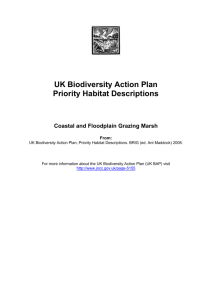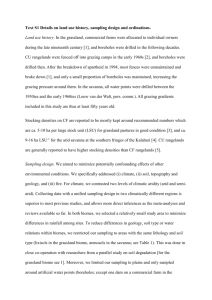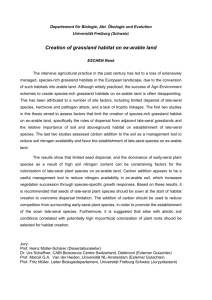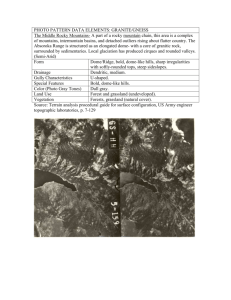FBI Prescription Sets: Marsh Fritillary
advertisement
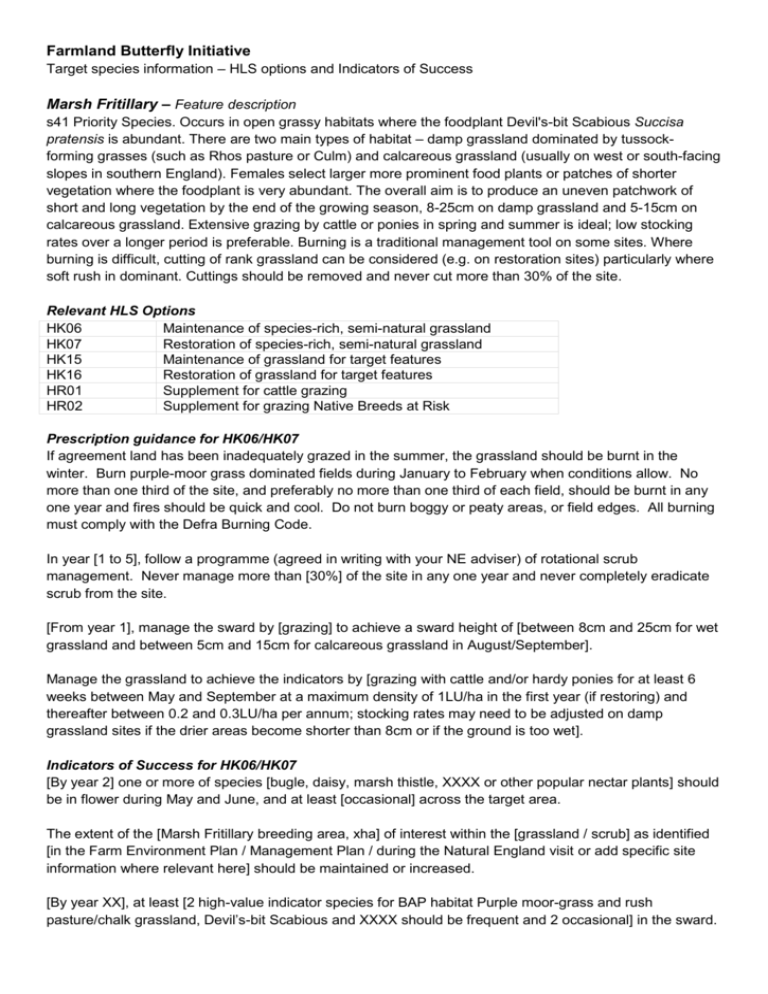
Farmland Butterfly Initiative Target species information – HLS options and Indicators of Success Marsh Fritillary – Feature description s41 Priority Species. Occurs in open grassy habitats where the foodplant Devil's-bit Scabious Succisa pratensis is abundant. There are two main types of habitat – damp grassland dominated by tussockforming grasses (such as Rhos pasture or Culm) and calcareous grassland (usually on west or south-facing slopes in southern England). Females select larger more prominent food plants or patches of shorter vegetation where the foodplant is very abundant. The overall aim is to produce an uneven patchwork of short and long vegetation by the end of the growing season, 8-25cm on damp grassland and 5-15cm on calcareous grassland. Extensive grazing by cattle or ponies in spring and summer is ideal; low stocking rates over a longer period is preferable. Burning is a traditional management tool on some sites. Where burning is difficult, cutting of rank grassland can be considered (e.g. on restoration sites) particularly where soft rush in dominant. Cuttings should be removed and never cut more than 30% of the site. Relevant HLS Options HK06 Maintenance of species-rich, semi-natural grassland HK07 Restoration of species-rich, semi-natural grassland HK15 Maintenance of grassland for target features HK16 Restoration of grassland for target features HR01 Supplement for cattle grazing HR02 Supplement for grazing Native Breeds at Risk Prescription guidance for HK06/HK07 If agreement land has been inadequately grazed in the summer, the grassland should be burnt in the winter. Burn purple-moor grass dominated fields during January to February when conditions allow. No more than one third of the site, and preferably no more than one third of each field, should be burnt in any one year and fires should be quick and cool. Do not burn boggy or peaty areas, or field edges. All burning must comply with the Defra Burning Code. In year [1 to 5], follow a programme (agreed in writing with your NE adviser) of rotational scrub management. Never manage more than [30%] of the site in any one year and never completely eradicate scrub from the site. [From year 1], manage the sward by [grazing] to achieve a sward height of [between 8cm and 25cm for wet grassland and between 5cm and 15cm for calcareous grassland in August/September]. Manage the grassland to achieve the indicators by [grazing with cattle and/or hardy ponies for at least 6 weeks between May and September at a maximum density of 1LU/ha in the first year (if restoring) and thereafter between 0.2 and 0.3LU/ha per annum; stocking rates may need to be adjusted on damp grassland sites if the drier areas become shorter than 8cm or if the ground is too wet]. Indicators of Success for HK06/HK07 [By year 2] one or more of species [bugle, daisy, marsh thistle, XXXX or other popular nectar plants] should be in flower during May and June, and at least [occasional] across the target area. The extent of the [Marsh Fritillary breeding area, xha] of interest within the [grassland / scrub] as identified [in the Farm Environment Plan / Management Plan / during the Natural England visit or add specific site information where relevant here] should be maintained or increased. [By year XX], at least [2 high-value indicator species for BAP habitat Purple moor-grass and rush pasture/chalk grassland, Devil’s-bit Scabious and XXXX should be frequent and 2 occasional] in the sward. In all years, populations of [Marsh Fritillary] should be maintained. [By year XX], cover of wildflowers in the sward (excluding undesirable species but including rushes and sedges), should be between [20% and 90%]. At least [40%] of wild flowers should be flowering during [May-June]. [By year 2 / 5], cover of invasive trees and shrubs [Willow spp. Birch and European Gorse] should be less than [20%, achieved by removing scattered small blocks and individual trees]. [By year 2], cover of species indicating water logging such as [Tufted Hair-grass /rushes /large sedges /Common Reed /Reed Canary-grass /Reed Sweet-grass / XXXX] should be less than [10%]. Prescription guidance for HK15/HK16 [From year 2 onwards,] manage the sward by [grazing with cattle/ponies] to achieve a sward height of between [8cm and 25cm for wet grassland and between 5cm and 15cm for calcareous grassland in August/September]. [do not exceed a stocking density of 0.3 LU per ha during April to September, stocking rates may need to be adjusted on damp grassland sites if the drier areas become shorter than 8cm or if the ground is too wet] In year [1 to 5], follow a programme (agreed in writing with your NE adviser) of rotational scrub management. Never manage more than [30%] of the site in any one year and never completely eradicate scrub from the site. Do not exceed a stocking density of [0.3 LU/ha] between [April and September] across [each field/the following fields XXXX]. Indicators of Success for HK15/HK16 [By year XX], at least [2 high-value indicator species for BAP habitat Purple moor-grass and rush pasture/chalk grassland, Devil’s-bit Scabious and XXXX should be frequent and 2 occasional] in the sward. [By year 2], species [Devil’s bit Scabious should be frequent within the sward with at least 30% in flower during August - September]. [By year 2 / 5], cover of invasive trees and shrubs [Sycamore / Blackthorn / Cotoneaster / Bramble / XXXX] [but excluding Bog Myrtle / Juniper / Creeping Willow / XXXX] should be less than [5% / 10%]. In all years, populations of [Marsh Fritillary] should be maintained. Prescription guidance for HR01 Cattle will be the [main] grazing species [from May to September with ponies also being suitable; sheep grazing is generally not suitable but winter and early spring grazing by sheep has been occasionally used to maintain suitable habitats on some chalk downland but needs careful monitoring]. They will comprise [at least 70%] of the livestock unit grazing days on the parcel. Further Information The butterfly is single brooded with adults flying from mid-May to mid-July, usually with a peak around the end of May to mid-June. The larvae form conspicuous webs that can easily be recorded in late summer to identify breeding areas and monitor populations. The Marsh Fritillary was once widespread in Britain but has declined severely over the last century (60% loss of range). Its populations are highly volatile and the species probably requires extensive habitats or habitat networks for its long term survival. The main foodplant is Devil’s-bit Scabious (Succisa pratensis). On calcareous grassland, it occasionally uses Field Scabious (Knautia arvensis) and Small Scabious (Scabiosa columbaria). Females lay eggs in large batches: the first may contain up to 350 but subsequent batches are smaller (c. 50–150). Females select larger, more prominent foodplants, or patches of shorter vegetation where the foodplant is abundant. The larvae are gregarious and form a protective web that becomes conspicuous in August to September The larval webs occur in intermediate length swards where the turf is 8–20 cm tall, although shorter swards of 5–15 cm can be used where foodplants are abundant (for example on downland). The larvae overwinter in their fourth instar, in a small web close to the ground, usually within a dense grass tussock. They emerge in early spring and can be seen in clusters of up to 150 black larvae, basking in weak sunshine. They eventually become solitary and can disperse widely over the breeding habitat. They pupate low in grassy vegetation, either deep within grass tussocks or amongst dead leaves. The Marsh Fritillary forms compact colonies, often on small patches of habitat. Marking studies have shown that most adults rarely fly more than 50–100 m but a proportion seem to disperse further. Initially females rarely move far, but they become more mobile after laying their first egg batch and have been known to colonize sites 10–15 km away. The butterfly is renowned for the large fluctuations in population size that make it highly prone to local extinction, but in good years it can spread and colonize new sites as well as less suitable habitat. It is therefore known to exist as metapopulations comprising groups of local populations connected by occasional dispersal. It is essential that the species is conserved at a landscape scale, by managing networks of suitable habitats. Management – Aim to produce an uneven patchwork of short and long vegetation by the end of the grazing period, between 8 and 25 cm high on damp grassland and 5-15 cm on chalk grassland. Grazing Extensive grazing by cattle or ponies in spring and summer is ideal on wetter sites, although autumn/winter grazing or all-year grazing can also be suitable. In general, a low stocking rate over a longer period is preferable. Stocking rates may also need to vary between different sites and between years. On most low productivity sites, stocking rates should not exceed 0.2-0.3 livestock units/ha/year. On seasonally grazed sites, roughly 1 cow every hectare (2.5 acres) for three months per year is recommended. Grazing animals should be removed if the drier areas become shorter than 8cm or if the ground is too wet. Proven systems include: hardy breeds of suckler cow, either pure bred or crossed with continentals; Holstein Friesian dairy replacements or stores; hardier beef stores, such as Welsh Black or Belted Galloway; and native ponies, such as Exmoor or Dartmoor. Improved land should be used for supplementary feeding where necessary to avoid damaging breeding habitats. Sheep grazing is generally unsuitable because they quickly remove large food-plants used for egg-laying. However very extensive or occasional sheep grazing may be acceptable though requires careful monitoring. Winter and early spring grazing by sheep has been successfully used to maintain suitable habitats on some chalk downland. Burning Burning is used to maintain some sites but it can kill Marsh Fritillary larvae. To minimise impacts on Marsh Fritillary populations and other insects: 1) Only burn on sites with a recent history of burning; 2) Burn between January/March; 3) Avoid burning more than one third of a field in a year; 4) Cool, quick fires are best but are difficult to control so cut firebreaks or use natural fire breaks such as wet areas or ditches. Mowing Mowing is unsuitable for Marsh Fritillary breeding areas. However, it may be used as a restoration tool particularly where Purple Moor Grass or rushes have become very dominant. Scrub cutting Some scrub cutting is necessary on most sites. It is best to cut a little each year, between October – February. When necessary treat the stumps with a suitable herbicide to prevent re-growth. Avoid clearing all the scrub as other insects and birds use it for shelter and breeding. Habitat networks The butterfly requires extensive habitat networks in order to survive (probably comprising many tens of hectares) and all potentially suitable habitat in a region should be targeted for management. In regions where habitat loss has been severe, habitat restoration should be given a high priority. A Factsheet (with ideal habitat management photographs) is available from Butterfly Conservation’s website which can be given to landowners.
